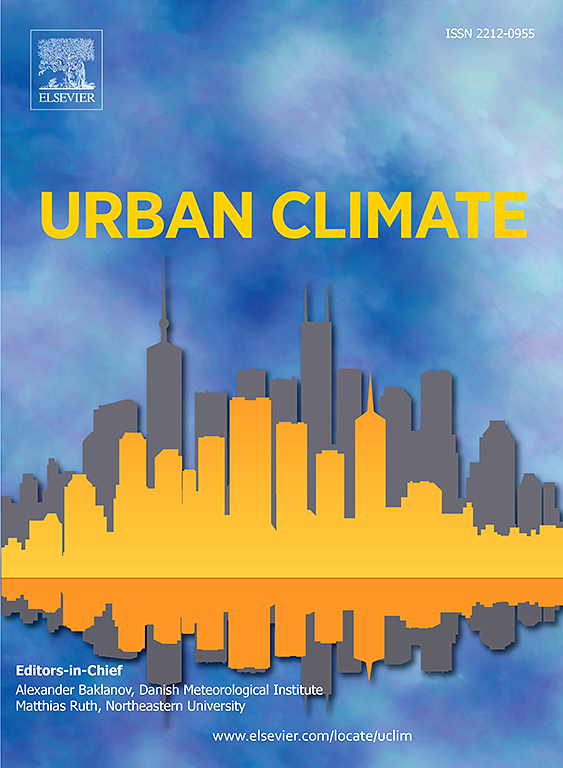城市化减缓了1970 - 2020年中国夏季湿性热浪的加剧
IF 6.9
2区 工程技术
Q1 ENVIRONMENTAL SCIENCES
引用次数: 0
摘要
城市热岛效应(UHI)加剧了极端高温,而同时存在的城市干岛效应(UDI)可能减轻热浪风险。目前尚不清楚城市化是否会增加或减少大规模热浪的风险。利用中国气象资料中心提供的逐日气象观测资料,采用城市-减去农村方法,分析了1970—2020年中国382个城市气象站夏季湿性热浪的演变特征。结果表明:83%的城市站点夏季湿性热浪频率、持续时间和强度显著增加,平均增幅分别为0.016次/年、0.009天/年和0.018°C/年;华南是全国增长最快的地区。以最近的农村站点为参考,城市化抑制了67%的城市站点夏季湿性热浪增加的趋势。平均而言,城市化使湿热浪的频率、持续时间和强度分别减少了75.0%、55.5%和38.9%。城市对东北湿性热浪发生频率、持续时间和强度的影响分别约为华中地区的9%、28%和64%。此外,城市化对极端湿热浪的影响主要由相对湿度的变化驱动。这些发现强调了城市化对湿热浪的广泛缓解作用,主要是通过城市热岛效应,并表明如果孤立地考虑城市热岛效应,城市化对热浪风险的影响可能被夸大了。本文章由计算机程序翻译,如有差异,请以英文原文为准。
Urbanization mitigates the intensification of summer wet heatwaves in China from 1970 to 2020
The urban heat island effect (UHI) exaggerates heat extremes, whereas the concurrent urban dry island effect (UDI) may mitigate heatwave risks. It remains unclear whether urbanization increases or decreases the risk of heatwaves at a large scale. Using daily meteorological observations provided by China Meteorological Data Service Center and urban-minus-rural method, this study analyzes the evolutionary characteristics of summer wet heatwaves at 382 urban meteorological stations in China during the period of 1970–2020. Results show that the frequency, duration, and intensity of summer wet heatwaves increased significantly in 83 % of the urban sites, with average growth rates of 0.016 times/year, 0.009 days/year, and 0.018 °C/year, respectively. South China experienced the fattest growth across China. Using the nearest rural site as a reference, the present research estimates that urbanization suppresses the trend of increasing summer wet heatwaves in 67 % of the urban stations. On average, urbanization reduces the frequency, duration, and intensity of wet heatwaves by 75.0 %, 55.5 %, and 38.9 %, respectively. The urban impacts on the frequency, duration, and intensity of wet heatwaves in Northeast China are approximately 9 %, 28 %, and 64 % of those observed in Central China, respectively. Additionally, the impact of urbanization on wet heatwaves extremes is primarily driven by changes in relative humidity. These findings underscore the widespread mitigating effect of urbanization on wet heatwaves, primarily through the UDI effect, and suggest that the urbanization effects on heatwave risk may be overstated if the UHI effect is considered in isolation.
求助全文
通过发布文献求助,成功后即可免费获取论文全文。
去求助
来源期刊

Urban Climate
Social Sciences-Urban Studies
CiteScore
9.70
自引率
9.40%
发文量
286
期刊介绍:
Urban Climate serves the scientific and decision making communities with the publication of research on theory, science and applications relevant to understanding urban climatic conditions and change in relation to their geography and to demographic, socioeconomic, institutional, technological and environmental dynamics and global change. Targeted towards both disciplinary and interdisciplinary audiences, this journal publishes original research papers, comprehensive review articles, book reviews, and short communications on topics including, but not limited to, the following:
Urban meteorology and climate[...]
Urban environmental pollution[...]
Adaptation to global change[...]
Urban economic and social issues[...]
Research Approaches[...]
 求助内容:
求助内容: 应助结果提醒方式:
应助结果提醒方式:


